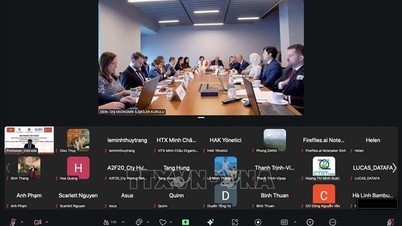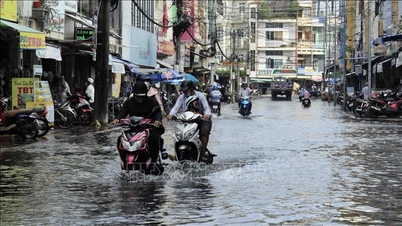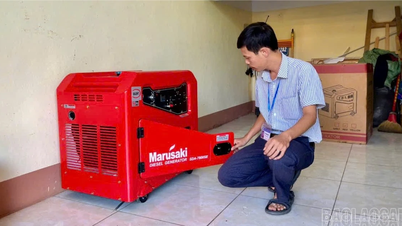Aviation expert Pham Ngoc Sau said that in the context of rapid urbanization and increasingly diverse transportation needs, low-altitude flights open up a remarkable socio -economic opportunity for Vietnam.
The world is witnessing a boom in this field. The US and Europe deployed it first in the cargo and medical sectors, then expanded to passenger services. In China, this country also identified low-altitude flying as a “low-altitude economy” with a target of trillions of yuan.

The demand for traveling by helicopter instead of road transport is increasing. Photo: Thu Huong
“South Korea, Japan and the UAE have already had pilot routes connected to airports and urban centers. The common point is to start with practical applications, demonstrate clear benefits, and then expand into a network,” expert Pham Ngoc Sau emphasized.
Regarding Vietnam, Mr. Sau said that we “can absolutely follow a similar roadmap”. Accordingly, the management agency can first pilot in areas with high industrial and tourist density such as Hanoi – Bac Ninh, Ho Chi Minh City – Dong Nai – Binh Duong , or Da Nang and Phu Quoc.
“If implemented skillfully, it will not only solve the traffic and logistics problem but also form a new value chain: from equipment manufacturing, building small landing and take-off points, maintenance and charging services, to online booking platforms. This can create more high-quality jobs and open up a new economic sector,” Mr. Sau said.
Still lacking legal corridor
Notably, according to expert Pham Ngoc Sau, low-altitude flights do not develop separately but also go hand in hand with general aviation. General aviation already has small airport infrastructure, training and operational capacity. Low-altitude flights bring new technology and new service needs. When combined, these two fields will complement each other, expanding the market size, effectively exploiting existing infrastructure, and enhancing the position of Vietnamese aviation in the region.
It is worth noting that low-altitude transport brings huge socio-economic benefits: from saving time, supporting logistics and emergency medical care, to opening up new value chains in equipment manufacturing, building small landing and take-off points, maintenance and charging services and digital coordination platforms. Vietnam has a special advantage as it is among the countries with a high rate of exporting innovative goods in the world.
This reflects our innovative manufacturing, design and service capabilities that can be fully leveraged for rapid commercialization of low-altitude flying models.
However, Mr. Sau frankly admitted that Vietnam currently has a policy to develop low-altitude air transport, but this activity cannot be implemented on a practical scale due to the lack of a specific legal corridor.
“We do not have clear regulations on dividing and managing low-altitude airspace, have not designed flight maps and flight methods suitable for urban environments, and have not fully developed coordination regulations between civil aviation, the military and local authorities to monitor and operate flight operations,” Mr. Sau acknowledged.
Sharing this view, Ms. Ho Thanh Huong, CEO of Bluesky Airways, acknowledged that low-altitude airspace has not been exploited effectively, and there are no specific regulations to encourage the exclusive exploitation of aircraft in this flight level.
In particular, currently helicopters are only allowed to take off and land at airports. This is not suitable because airports with long runways are designed for fixed-wing aircraft. Helicopters need to land at helipads instead of traditional airports because this is a vertical take-off and landing aircraft.
“Towing a helicopter to the runway takes a lot of time, and the helicopter’s low flight speed affects the general traffic flow at the airport. In addition, the current flight permit process takes too much time while the travel needs of this type of aircraft need to be met immediately.
Exploiting potential, building new value chains
Mr. Sau affirmed that if a feasible legal corridor is not soon formed, Vietnam will miss the opportunity to capture the market and build domestic capacity, while other countries are accelerating with testing frameworks and pilot routes.
Therefore, it is urgent to soon issue pilot regulations, identify low-altitude flight corridors in some key urban and industrial zones and set minimum standards for small take-off and landing points. This is a step that will help us not only keep up but also surpass thanks to the advantage of innovation and export capacity.
“In big cities with frequent traffic jams, low-altitude flight services can create a new transport channel, quickly connecting from the center to the airport, from warehouses to hospitals or industrial zones, while also serving medical emergencies and experiential tourism. In particular, famous destinations such as Ha Long, Ninh Binh, Da Nang or Phu Quoc can completely develop sightseeing flights and high-end passenger pick-up services,” Mr. Sau said.

The need to travel by helicopter instead of road transport is increasingly evident.
As a pioneer in opening the general aviation market, with many years of experience participating in the aviation market, female CEO Ho Thanh Huong realized that helicopter travel services to serve the travel needs of business people had not been deployed by any civil airlines.
However, the domestic market is considered to have great potential, especially in the context of increasingly congested road traffic. Therefore, the need to travel by helicopter instead of road transport is increasingly evident.
"The use of alternative means to reduce pressure on road traffic in increasingly crowded traffic conditions is urgent. We affirm that the demand is there and very high, especially among businessmen and for medical emergency and rescue operations. Seizing this opportunity, Bluesky Airways has signed to purchase two long-range medium-range helicopters from the Italian brand Agustar Westland, including one AW139 and one AW189. These aircraft will begin to be delivered in the second half of 2026," Ms. Huong shared.
Ms. Huong expressed her hope that general aviation and low-altitude flying vehicles will receive attention and development as in many countries around the world. Accordingly, the management agency will soon issue regulations on management and licensing of low-altitude flying vehicles, including helicopters, similar to those in developed countries.
In addition, Ms. Huong also proposed that flight licensing regulations should be flexible to meet the travel needs of business customers and tourists. In particular, helicopters will have their own parking lots and be allowed to take off and land at these parking lots instead of using traditional runways.
In the Draft Law on Aviation Amendments, the drafting agency has created a framework with the goal that when the Law comes into effect, the sky can be managed... in a more open direction, creating favorable conditions for low-altitude flight activities, including general aviation.
It is known that the draft revised Law on Aviation is expected to be submitted to the National Assembly for consideration and approval at the 10th Session (October 2025).
A representative of the Civil Aviation Authority of Vietnam - the agency assigned by the Ministry of Construction to preside over the drafting of the revised Law on Civil Aviation, said: "In response to the direction of the National Assembly Standing Committee on the draft Law on Civil Aviation, the drafting agency has accepted and added a number of provisions and policies to serve low-altitude transport activities - laying the foundation for low-altitude economic development.
Vietnamnet.vn
Source: https://vietnamnet.vn/vung-troi-ngu-yen-va-co-hoi-cho-viet-nam-2449534.html





![[Photo] Prime Minister Pham Minh Chinh chairs a meeting of the Government Standing Committee to remove obstacles for projects.](https://vphoto.vietnam.vn/thumb/1200x675/vietnam/resource/IMAGE/2025/10/06/1759768638313_dsc-9023-jpg.webp)
![[Photo] Prime Minister Pham Minh Chinh chaired a meeting of the Steering Committee on the arrangement of public service units under ministries, branches and localities.](https://vphoto.vietnam.vn/thumb/1200x675/vietnam/resource/IMAGE/2025/10/06/1759767137532_dsc-8743-jpg.webp)








![[Photo] Prime Minister Pham Minh Chinh chairs the Government's online conference with localities](https://vphoto.vietnam.vn/thumb/402x226/vietnam/resource/IMAGE/2025/10/5/264793cfb4404c63a701d235ff43e1bd)

![[Photo] Prime Minister Pham Minh Chinh launched a peak emulation campaign to achieve achievements in celebration of the 14th National Party Congress](https://vphoto.vietnam.vn/thumb/402x226/vietnam/resource/IMAGE/2025/10/5/8869ec5cdbc740f58fbf2ae73f065076)



















































































Comment (0)